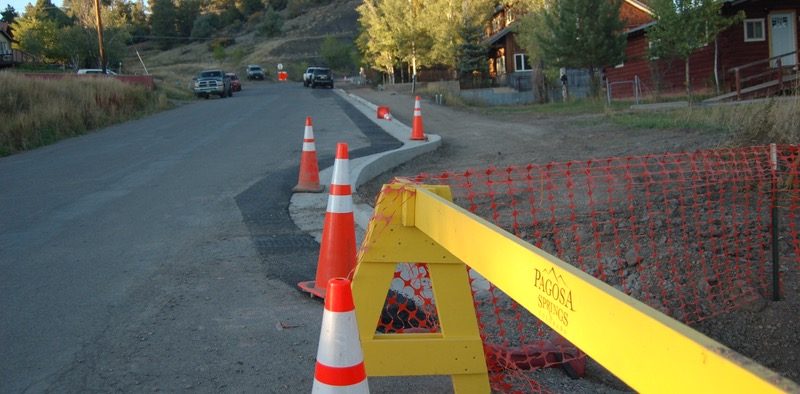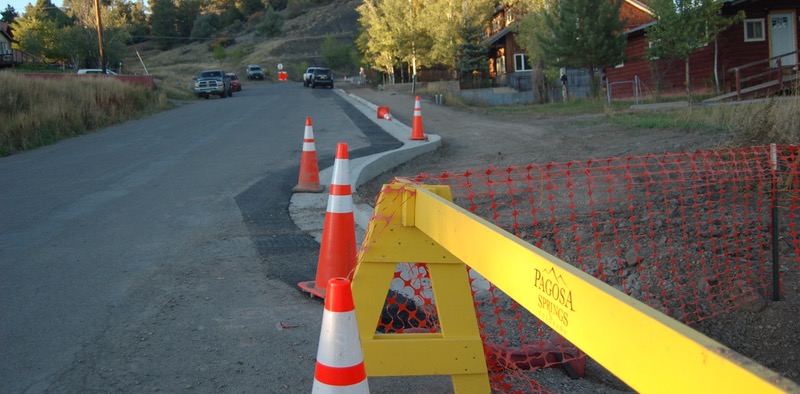We have an ambitious construction project going, on a couple of blocks east of my house on the north side of downtown Pagosa: three blocks of new sidewalk on one side of the street, on two blocks of Florida and one block on North 8th. These stretches of sidewalk are not simply replacement; they’re brand new sidewalks where the town has never had sidewalks before.

Although Pagosa Springs was first surveyed and platted in 1883, and incorporated in 1891, almost none of the residential neighborhoods have ever had sidewalks installed. The ranching-and-lumber economy and the small population, for the first 100 years, did not allow for such urban features as paved streets and sidewalks and storm drains, except in the core commercial area, and even when the population of Archuleta County began to grow — doubling between 1970 and 1990, and then doubling again between 1990 and 2010 — and even when the downtown streets finally got pavement, very few sidewalks were installed to serve the residential parts of downtown.
The three blocks of new sidewalk now being installed on Florida and North 8th probably never would have happened, if the US Department of Transportation had not developed a grant program called Safe Routes to Schools. From the Safe Routes web page:
Safe Routes to School (SRTS) is an approach that promotes walking and bicycling to school through infrastructure improvements, enforcement, tools, safety education, and incentives to encourage walking and bicycling to school. Nationally, 10%–14% of car trips during morning rush hour are for school travel. SRTS initiatives improve safety and levels of physical activity for students. SRTS programs can be implemented by a department of transportation, metropolitan planning organization, local government, school district, or even a school. Extensive resources are available through a national center, including an SRTS Guide, parent surveys and student tallies, and simple strategies such as the walking school bus, that schools can use to support bicycling and walking.
It’s been pretty well documented that walking is a natural human activity, and that our overall health can benefit from walking and other convenient forms of daily exercise. And for the first 100 years of Pagosa’s history, children walked or rode their bikes (or horses) to school. All three of our public school campuses are still located within convenient walking and bicycling distance for downtown residents.
But only about 15 percent of the community population lives in the downtown area, and close to 100 percent of our school children ride a school bus to school, or get dropped off by parents, or have their own vehicle. (Our local public charter school, Pagosa Peak Open School, is located uptown in the Aspen Village “live, work, play” subdivision, but speaking as a board member who visits the school regularly, I can’t say I’ve ever seen a child arrive there on foot or on a bicycle.)
So the three blocks of “Safe Routes to School” sidewalk on Florida and North 8th present any interesting situation. This route could, theoretically, be used by children walking or biking from the north downtown neighborhood to Pagosa Springs Elementary School — a school serving K-4 students — but the children would have to cross Highway 160. I’m not sure how many parents would feel secure sending their Kindergarten age child on such a route, during rush hour.
In fact, in my 25 years living in downtown Pagosa’s north neighborhood, I can’t recall ever seeing an elementary school child walking or riding, unattended, to the elementary school. But thanks to the federal government, we will now have a concrete sidewalk along this “Safe Route to School.”
The Town budgets suggest that this three-block project, when complete, will have cost the taxpayers about $400,000.
As we mentioned, most of the downtown neighborhoods still have no sidewalks, nor do they have much traffic, pedestrian or vehicular. The busier downtown streets — Lewis Street, South 8th Street, Hot Springs Boulevard — do indeed have sidewalks, and all of these routes are used by older children walking or biking to the Middle School or High School.
Over the past several months, the Town Council has been discussing sidewalk maintenance, because we do have a few sidewalks now, and they do need maintenance now and then. For who knows how long, most municipalities in Colorado have declared that, when a sidewalk exists in front of a home or business, the owner of that home or business property is legally responsible for the maintenance of “their” sidewalk. This is a somewhat odd approach, legally speaking, because the sidewalks are not actually on the individual owner’s property — the sidewalk is always within the town-owned right-of-way — and the property owner probably didn’t install the sidewalk, and may not be the primary user of the sidewalk.
But by declaring that the property owner is “responsible” for something he never installed, and does not own, and may not even use, the municipality relieves itself of liability in case someone is injured while walking on a poorly-maintained sidewalk that the town has proclaimed to be someone else’s responsibility.
Something rather remarkable happened here in Pagosa, as a result of several months of discussion at Town Council meetings. The Town Council made a decision that, because our sidewalks are publicly owned and used by the general public, and because most of the sidewalks were designed and installed by the Town government, the Town — not the individual property owners — ought to be responsible for the maintenance of those sidewalks.
This will not be an inexpensive decision, in terms of future Town expenditures.
Nor would it be an inexpensive decision to produce a long-range plan to install sidewalks throughout the downtown core, on all of the numerous streets where they do not yet exist. Maybe in the next 100 years?

